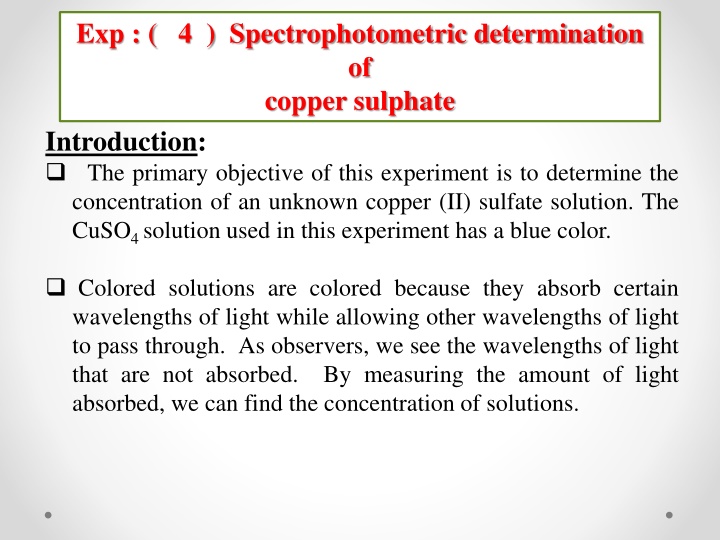
Spectrophotometric Determination of Copper Sulfate Solution
Explore the spectrophotometric determination of copper sulfate solution with an unknown concentration using absorption spectrum analysis, calibration curves, and Beer's Law. Understand the process of preparing standard solutions, measuring absorbance, and finding the maximum wavelength for accurate analysis.
Download Presentation

Please find below an Image/Link to download the presentation.
The content on the website is provided AS IS for your information and personal use only. It may not be sold, licensed, or shared on other websites without obtaining consent from the author. If you encounter any issues during the download, it is possible that the publisher has removed the file from their server.
You are allowed to download the files provided on this website for personal or commercial use, subject to the condition that they are used lawfully. All files are the property of their respective owners.
The content on the website is provided AS IS for your information and personal use only. It may not be sold, licensed, or shared on other websites without obtaining consent from the author.
E N D
Presentation Transcript
Exp : ( 4 ) Spectrophotometric determination of copper sulphate Introduction: The primary objective of this experiment is to determine the concentration of an unknown copper (II) sulfate solution. The CuSO4 solution used in this experiment has a blue color. Colored solutions are colored because they absorb certain wavelengths of light while allowing other wavelengths of light to pass through. As observers, we see the wavelengths of light that are not absorbed. By measuring the amount of light absorbed, we can find the concentration of solutions.
Anhydrous (without water) CuSO4 is gray-white in colour.but the more common CuSO4.5H2O is a lovely shade of light blue, and CuSO4 is dissolved in water and forms a blue solution. That is because it absorbs light in the red-orange region of the spectrum. So your eyes perceive it a being blue. Before doing this type of spectral analysis, the wavelength at which absorbance is greatest needs to be determined. This is the wavelength to be used for the analysis.[maximum wave length max
How to find maximum wave length ? Maximum wave length gives a maximum absorbance. It can be found by taking the absorbance of a fixed concentration of color solution at different wave length. By plotting a curve between absorbance & wave length we can get the maximum wave-length as shown in this figure: Maximum wave length Wave length Absorbance 590 592 594 596 --- ---- ---- ----- ---- ------ ------ ----- ----- ----- ------ ------
Calibration curve 1- Preparation of standard solution ( stock solution) 2- Preparation of serial standard solution from the stock solution 3- Plot a graph between the concentration and absorbance 4- Find the absorbance of unknown sample Test Tube Concentration of CuSO4 (M) Absorbance 1 2 3 4 5
Procedure Exp: ( 4 ) Spectrophotometric determination of CuSO4.5H2O 1- Prepare a standard copper solution at 0.4M by first calculating the required amount of pure CuSO4.5H2O in 100 ml distilled water. The obtained solution is named stock solution. 2-Label six clean, dry, test tubes 1 6. Use pipets to prepare five standard solutions according to the chart below.
Test Tube 0.40 M CuSO4(mL) Distilled H2O(mL) Concentration(M) 1 0 10 2 2 8 3 4 6 4 6 4 5 8 2 6 10 0 3- Measure the absorption spectrum , of this CuSO4.5H2O standard between 590 nm and 700nm , from the absorption spectrum select the optimum wave length to use for all absorbance measurements. By drawing a curve between absorbance and wave length.
4- Measure the absorbance of all six standard solution and the unknown solution after measuring the absorbance of blank solution 5- Draw a calibration curve between absorbance and concentration and find the concentration of the unknown solution.
Electrolyte solutions behave as an electrically conductive medium. The change of electrolyte conductivity can indicate the change of the concentration of the total ions, this method is defined as counductumetric Analysis Conductivity is measured by using conductometer.Units of conductivity is mhos (1 -1 ) , where 1S=1 -1 The magnitude of counductumetric titration is based on Ohm s law. 1 0 10
Ohms law: R = V / I Where R = resistance (ohms), V = voltage (volts), I = current (amps) Total conductance of the solution is directly proportional to the sum of the n individual ion contributions . G = ci i 5 11
Factors affecting conductivity: Size of ions Temperature Number of ions Charge of ions Uses of conductometric method 1- Determination solubility products. 2- Find the dissociation constants (K a). 3- To detect the end point of titration. 4- Other properties of electrolyte solutions. 12
CONDUCTOMETRIC TITRATIONS: The determination of end point of a titration by means of conductivity measurements are known as conductometric titrations. Types of conductometric titrations: Acid-base titration Precipitation titration Redox (oxidation-reduction) titration Complexometric titration 13 13 13
conductance OH - H + L Equivalence Point volume V (ml) NaOH ( N x v ) Hcl = ( N x V ) NaOH Conductometric Titration of Hcl with NaOH 14 14
A) Titration of HCl with NaOH ( A ) / Consider what happened when hydrochloric acid is titrated with sodium hydroxide solution .: 1. Initially the conductivity is quite high because of the high equivalent Conductance (mobility) of hydrogen ions. 2. The hydrogen ions are replaced by the same number of sodium ions But those have a very low mobility, so that the over all conductance decrease steeply to the equivalence point. 3. After this point is passed, the conductance increase again as both the solution and hydroxide ions accumulate in the solution. HCl H + + Cl - HCl + NaOH NaCl + H2O Mobility 0 H + = 350 ohm-1 cm-1 : 0 Na + = 50 ohm-1 cm-1 : 0 OH - = 198 ohm-1 cm-1 15 15
B) Titration of CH3COOH with NaOH Initially the solution has a law conductance : CH3COO - + H + CH3COOH As neutralization proceeds ,conductance decrease CH3COOH + NaOH After ( e.p) the conductance of the solution increase because of increase the ( OH -) conc. NaOH Na + + OH - CH3COONa + H2O 16 16
conductance Equivalence Point volume V (ml) NaOH ( N x v ) CH3COOH = ( N x V ) NaOH Conductometric Titration of CH3COOH with NaOH 17 17
Procedure EXP . ( 5 ) Conductometric titration of HCl and CH3COOH with NaOH ,determination of Ka for acetic acid 1.Take ( 10 ml) of HCl sample and dilute to ( 100 ml) with ( D.W) . Place the beaker containing your sample on the magnetic stirrer. Lower the conductivity cell into the beaker until it is covered. 2.Take the initial reading and then add ( 0.5 ml) of NaOH ( 0.2 M) in burette. 3.In the same manner titrate ( 50 ml) of CH3COOH unknown sample .Add ( 0.2 until 2 ml ) of NaOH continue the titration in ( 0.5 until 10 ml) of the ( 0.2 M) NaOH is add. 18 18
4.Rinse the conductivity cell and store in ( D.W) . 5.Calculate the M of HCl and CH3COOH .And dissociation constantfor CH3COOH. 19 19
Determination Ka for acetic acid : Ka = [ H+] [ OAC-] / [ HOAC] = ^ HOAC ^ ^ = L x 1000 / C Ka = C 2 / 1 - , ( ^ = 430.7 ) ( Conc. CH3COOH : ( N X V CH3COOH ) = ( N X V NaOH ) NOTE: Use platinum electrode in conductometry measurement 20 20
The concentration of an element in a solution is determined by measuring the absorption, emission or fluorescence of electromagnetic by its monatomic particles in gaseous state in the flame. 21
Flame Emission oAtoms in gaseous state in the flam absorb thermal energy from the flame itself ,some of the atoms get excited & as they return back to the ground state they emit radiation having energy equal to that absorbed. o The emission is proportional to the number of excited atoms, which is proportional to the total number of atoms in the flame i.e. the sample concentration Na Na * Energy from flame Na * Na + h Proportional to conc. 22
Flame photometry: is an atomic emission method for the routine detection of metal salts , principally Na , K , Li , Ca and Ba . The method is selective to ward detection of alkali and alkali earth metals and simple, inexpensive, used for clinical, biological ,and environmental analysis. Flame photometry is limited because the temp. of flam is not high enough to excite other or transition metals. 23
INSTRUMENT FOR FLAME EMISSION 1-Flame atomizer. 2- Monochromator 3- Detector. 4- Readout meter. 24
flame Dc amplifier Photo multiplier fuel recorder oxidant monochromator sample Flame photometry diagram 25
The temperature of the flame produced depends on (fuel-oxidant ) ratio and kind. Fuels Oxidants Hydrogen Air Acetylene Oxygen Propane Nitrous oxide 26
1- The solvent is evaporated leaving minute particles of dry salt ( S ). 2- The dry solids are converted into the gaseous state. 3- Apart of all the gaseous molecules are dissociated to give neutral atoms' or radicals. The atomization step. 4-Apportion of the neutral atoms may be thermally excited. 5-Some of the neutral atoms may combine with radicals in the flame gases to form new gaseous compounds. 27
THE PROCESS THAT DONE INSIDE THE FLAM : Sample nebulization dessolvated Vaporized Atomized h return to a lower ground stat excited electronic state (Flam photometry) Those which are activated (excited) will drop back to ground state with the emission of a photon of radiation which can be identified and measured with a suitable (flam photometry). 28
Exp. No. (6) Determination of sodium and potassium in soil by flame photometry Procedure 1. Preparation of Stock solution: Prepare (100 ppm) of Na+ from NaCl in (250 ml). Prepare (100 ppm) of K+ frome KCl in (250 ml). 2. Preparation of Calibration Curve: - Prepare (5,10,15, 20, 25 ppm) of Na+ from the stock solution, Complete the volume to (50 ml) by (D.W.). - Prepare (10, 20, 30, 40, 50 ppm) of K+ from the stock solutionComplete the volume to (50 ml) by (D.W.). 29
3. Preparation of the unknown: Weight (2 g) of soil, add (5 ml) of conc. HCl heat for (2 min), add a few drops of (D.W.) and filter the solution then complete the volume to (50 ml). 4. Set the instrument to read 100% for the most concentrate Na+ solution, determine the intensity of the other Na+ solution as compared to this. Run of sample. 5. Set the instrument to 100% with the most concentrated K+ Solution. Read the intensity of the K+ solutions as compared to this. Run an unknown sample. 6. Determine the concentration of Na+, K+ in the sample. 30
Emission % conc. unknown Conc. ppm ( Na ) Calibration curve for Na or K 31
Prepare (100 ppm) of Na+ from NaCl in (250 ml). 100 ppm = 100 mg /L = 100 1000 g PPm = M x M.wt x 1000 = 0.1 g / L = 0.1 / 4 = 0.025 g/ml Na+ Na+ NaCl At wt = 23 m.wt = 58.5 0.025 x X= 58.5 x 0.025 / 23 x = 0.06gm
2- Preparation of solutions from Liquids. 1-First step 2- Second step ( M1 V1 ) concentration = ( M2 V2) dilution





















